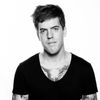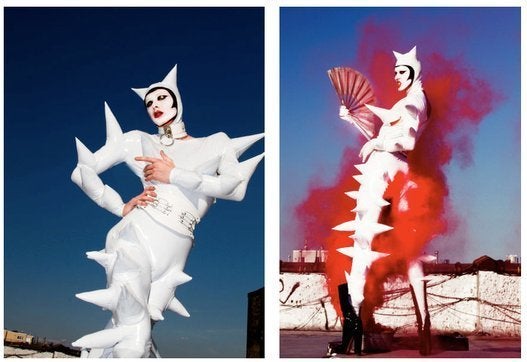This is the fifth installment in a series that elevates the work of up-and-coming queer individuals working in the fashion world. Check back at HuffPost Gay Voices regularly to learn more about some of the designers of tomorrow and the way their work in fashion intersects with their queer identity.
Julia Shapiro is a young fashion designer and recent graduate of Cornell University living and working in New York. Though Shapiro doesn't identify as queer, her brand, J SHAP, informs a queer understanding of radical self-expression and self-determinism that translates through her designs and the overarching ideology. The greenest designer featured in this miniseries, Shapiro orchestrated a guerrilla-style presentation of her line at last year's New York City fashion week, drawing attention to her garments when she crashed the outside of Mara Hoffman's show. Embodying a philosophy that encourages individuals to "reject the business of fashion and give yourself over to the art of fashion," Shapiro is currently planning another guerilla-style "takeover" of fashion week in September of this year. Read the interview below to learn more.
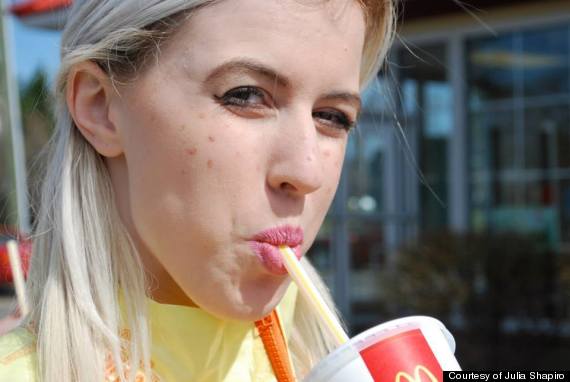
The Huffington Post: What has your journey as a fashion designer entailed?
Julia Shapiro: I have always wanted to be a fashion designer for as long as I can remember. It all started with a Manolo Blahnik sketch book I got when I was young and morphed into what it is today. I attended Cornell University’s Fiber Science and Apparel Design program but quickly realized I was unhappy with the lack of design focus. I felt like my loudness and craziness was being stifled and watered down by the atmosphere and feedback from my colleagues and teachers. Nobody really understood it. So, I left for my junior year and did an urban semester program in NYC in the fall, attending London College of Fashion abroad in the spring. This period of turmoil -- as well as what I turned it into -- was really when I found the confidence and boldness I have now. I came back with a whole new attitude about my work, finally understanding how to make the program I was in work for me. I think that always questioning, going against the grain, and not putting up with bullshit are what has got me to where I am today.

What is the nature of the work you produce? Why do you use a lot of recycled materials?
At the base of all my work is a commentary on consumption and the themes that go along with that: i.e. globalization, mass marketing/manipulation, obsession, anything that is “so American.” I like to apply these themes in an ironic way -- they are at the center of my aesthetic but they are also what I am fighting against. For example, a picture of a McDonald's sign next to an American flag would be something I would love -- an ironic glorification of something so American that it is beautiful but, in reality, actually sucks about our culture. The concept of "so bad it's good" is a solid way to describe it.
This is why I use a lot of recycled materials; fabric stores are very limiting, especially when it comes to these themes. Using recycled materials takes away all of the boundaries and allows me to literally create the garments out of the themes I am working with. For example, using beanie babies or hamburger wrappers to construct my garments. Even the work I do with recycled t-shirts is intentional because of the logos. Working this way not only frees me from limitations but it also encourages creativity because certain items will inspire me to make them into something I wouldn’t think to sketch.

While you don't identify as queer yourself, I would argue that your work speaks to a queer aesthetic. What is the underlying philosophy driving your brand?
The driving philosophy of my brand is self expression, baby! I look at fashion as escapism and identity exploration in the same way that Leigh Bowery and the club kids did. I try to push people a bit outside of their boundaries in every aspect of my life, encourage people to be more open, fun and self expressive. Through my clothes I do this by making things that people can’t say no to. I find a lot of “weird” or “out there” clothes are made with either no sense of aesthetic eye or taste level -- or else they are radically expensive. With my work I make it so that people relate to it, want it, look good and feel confident in it. If I can be the designer who prompts someone to buy one piece a bit outside their comfort zone that they love, that is almost like the gateway drug to being self-expressive and loud in other arenas of their lives.
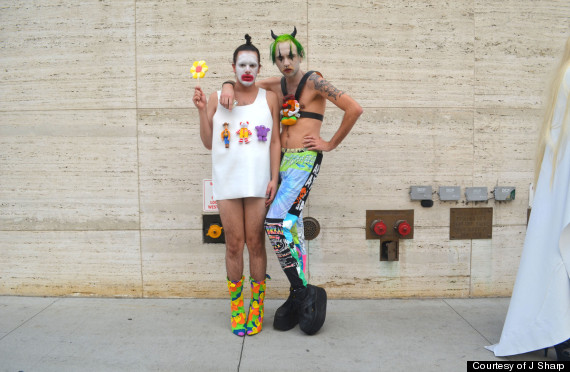
Why do you think your work has such a driving appeal to the queer community?
This aspect of self expression has always been aligned with the queer community. Those in the queer community are almost like the ambassadors of self-expression in my mind. There needs to be identity exploration in order to come to the conclusion that you are queer, and a big part of that exploration is through dress. Once you become comfortable and open with your sexual orientation (which is a hard thing to do) you become fearless. Fearless people have no problem with expressing themselves, and that's why I gravitate towards drag queens, gender benders, taste makers, etc. for my brand -- and also why I appeal to them. It doesn’t matter at all how someone identifies themselves to me, it’s all about the attitude.
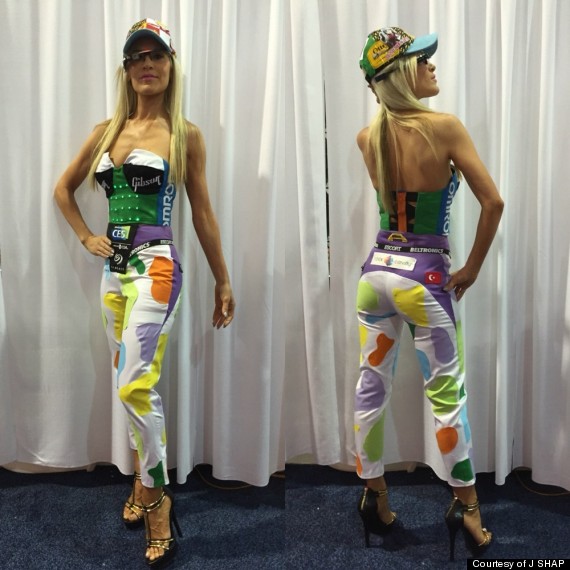
What did your "takeover" of Fashion Week last year entail?
I was always told, like everyone else was, how New York City is this amazing creative hub where you need to be if you are in the fashion or art world. After living in NYC a handful of times for internships and art programs, I felt uneasy. Why wasn’t I feeling the way everyone else seemed to feel? Where was this magic I was told about? I had also lived in LA one summer to intern with Jeremy Scott and London for a semester abroad. These places seemed way more current in terms of self expression and fashion but, realistically, all arrows still pointed to NYC. For some reason I was unhappy with this.
It was one tireless night right after graduation that I was grappling with this dilemma and realized it wasn’t me, it was that NYC, in regards to the fashion scene, is not current. The mythos of New York Fashion, and the keywords traditionally associated with it -- groundbreaking, unique, creative, self-expressive -- are defunct. What remains is a handful of watered-down design houses relying on a dated reputation using spread sheets, trend forecasting and other statistics to pump out collections that will sell to the masses with generic (and unearned) praise best described as “conservative chic.” Many of these “designers” don’t show passion, they don’t create worlds, they aren’t doing anything new. I want fashion to come back to being an art, treated more democratically, with individuals having unique opinions rather than being dictated to by the market. I want to revive the spirit of what New York once was -- you should be able to tell a New Yorker from a tourist just by looking at them. This is why I chose to do the takeover, to point out the shortcomings of New York fashion week, to stick it to the man, to say fuck the system.
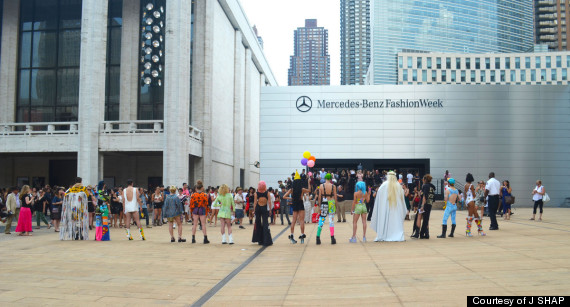
What do you feel like was accomplished by the takeover? What are you trying to articulate about the fashion industry and the future of fashion?
The takeover proved that people are ready and receptive to this type of change in the fashion scene. Photographers literally ran out of the tents at fashion week during Mara Hoffman’s show to get pictures of us. Everyone loved it and was really supportive. Some people even joined in. Honestly, this type of fashion makes people smile, whether they are loving it or appalled. Fashion is getting way too serious and stale. Yeah, putting on a top designer outfit may make you feel accomplished because of the label stitched on the inside, but the clothing I am making makes you feel happy, take on a different persona, attitude, or air. My brand, as well as this type of self expression, is just that on a larger scale. I want the future of fashion to be that people stop looking at clothes as a necessity but to look at it as personal adornment once again. For it to be more democratic in terms of designers who get praise, for people to have their own list of favorite designers, have opinions that are devoid of that of the industry, and to own pieces that will make them feel proud to wear. Reject the business of fashion and give yourself over to the art of fashion.
What is next for J SHAP?
The response to my takeover has prompted another event for fashion week this coming September that will remain to be seen. I have also been working on building inventory so that people will be able to start purchasing J SHAP! Recently I have launched a long-term series called "Dress Up With J SHAP" in which I invite friends into my studio to explore and create looks with my clothes, a sort of free-form photo shoot that is very organic to come up with looks, inspiration, and get great shots through the lenses of the person I'm working with, the environment, and the supplies/garments I have. I have also come to the conclusion that fashion as art should be seasonless, collections should come out as ideas are finished just as art series come out. This means that collections can come out as frequently as lookbooks or on the other hand can be given more time and attention if an idea calls for it. This also means that the silhouettes in the collections do not have to adhere to a set of rules set by a season but can be reflected solely by the inspiration and what the collection calls for. So you can look forward to a lot of new collections coming from J SHAP.
Most recently I was invited to attend the Consumer Electronics Show in Las Vegas, the largest trade show in the world which pioneers cutting edge and upcoming technologies, to gather the free giveaways and in less than 24 hours create a wearable technology look with the "swag" I gathered around the convention. This was my first exploration into wearable tech, integrating LED technology into the bodice controlled by an easy to use app, and hopefully I will be able to integrate more of this in the future.
Want to see more from J SHAP? Head here to check out the designer's website. Missed the previous installments in this series? Check out the slideshow below.
